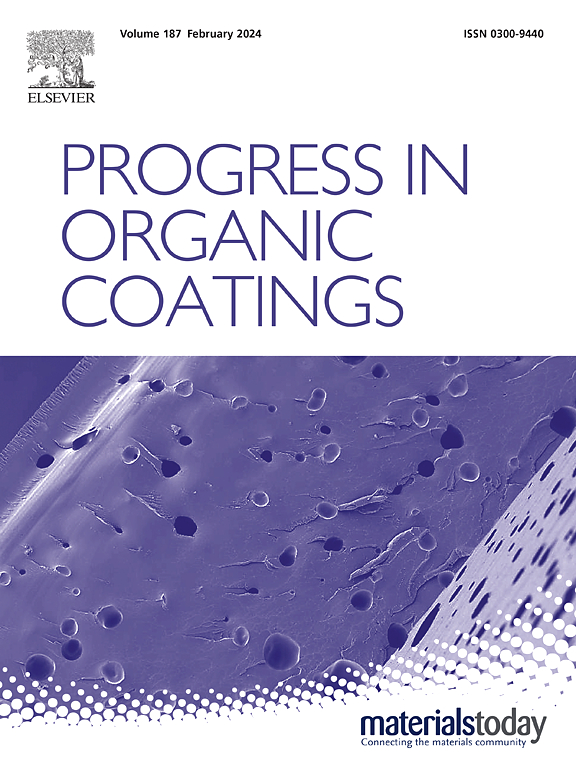Robust pH-responsive double-layered self-healing coating with synergistic effects of tannic acid and Ce ions applied on Mg alloy via the phytic acid pretreatment
IF 6.5
2区 材料科学
Q1 CHEMISTRY, APPLIED
引用次数: 0
Abstract
Synergistic effect of various inhibitors can impart excellent self-healing properties to organic coatings. Here, we designed a pH-responsive double-layered self-healing system (P![]() Ce/DMS-TA@CS-EP) comprising the underlying phytic acid conversion film containing Ce ions and the upper epoxy coating (EP) involving tannic acid (TA)-loaded dendritic mesoporous silica (DMS) encapsulated with chitosan (DMS-TA@CS). The phytic acid conversion film, as a pretreatment layer, can make the adhesion force of P
Ce/DMS-TA@CS-EP) comprising the underlying phytic acid conversion film containing Ce ions and the upper epoxy coating (EP) involving tannic acid (TA)-loaded dendritic mesoporous silica (DMS) encapsulated with chitosan (DMS-TA@CS). The phytic acid conversion film, as a pretreatment layer, can make the adhesion force of P![]() Ce/DMS-TA@CS-EP/substrate (8.32 MPa) increase by approximately twofold compared with EP/substrate (4.02 MPa). Meanwhile, its micro-cracks are also employed to load Ce ions. DMS-TA can be wrapped by CS through electrostatic interactions. TA is released from DMS-TA@CS in response to pH stimulation. The superior self-healing abilities of P
Ce/DMS-TA@CS-EP/substrate (8.32 MPa) increase by approximately twofold compared with EP/substrate (4.02 MPa). Meanwhile, its micro-cracks are also employed to load Ce ions. DMS-TA can be wrapped by CS through electrostatic interactions. TA is released from DMS-TA@CS in response to pH stimulation. The superior self-healing abilities of P![]() Ce/DMS-TA@CS-EP mainly originate from the synergistic effect of TA and Ce ions. The low frequency impedance modulus of P
Ce/DMS-TA@CS-EP mainly originate from the synergistic effect of TA and Ce ions. The low frequency impedance modulus of P![]() Ce/DMS-TA@CS-EP (9.94 × 1010 Ω·cm2) is two orders of magnitude higher than that of EP (8.45 × 108 Ω·cm2) after 60 days of immersion, indicating that P
Ce/DMS-TA@CS-EP (9.94 × 1010 Ω·cm2) is two orders of magnitude higher than that of EP (8.45 × 108 Ω·cm2) after 60 days of immersion, indicating that P![]() Ce/DMS-TA@CS-EP possesses durable anti-corrosion performance. This synergistic strategy will offer a highly effective approach for preventing/mitigating the corrosion of metal.
Ce/DMS-TA@CS-EP possesses durable anti-corrosion performance. This synergistic strategy will offer a highly effective approach for preventing/mitigating the corrosion of metal.

通过植酸预处理在镁合金上应用具有单宁酸和 Ce 离子协同效应的强 pH 响应型双层自修复涂层
本文章由计算机程序翻译,如有差异,请以英文原文为准。
求助全文
约1分钟内获得全文
求助全文
来源期刊

Progress in Organic Coatings
工程技术-材料科学:膜
CiteScore
11.40
自引率
15.20%
发文量
577
审稿时长
48 days
期刊介绍:
The aim of this international journal is to analyse and publicise the progress and current state of knowledge in the field of organic coatings and related materials. The Editors and the Editorial Board members will solicit both review and research papers from academic and industrial scientists who are actively engaged in research and development or, in the case of review papers, have extensive experience in the subject to be reviewed. Unsolicited manuscripts will be accepted if they meet the journal''s requirements. The journal publishes papers dealing with such subjects as:
• Chemical, physical and technological properties of organic coatings and related materials
• Problems and methods of preparation, manufacture and application of these materials
• Performance, testing and analysis.
 求助内容:
求助内容: 应助结果提醒方式:
应助结果提醒方式:


